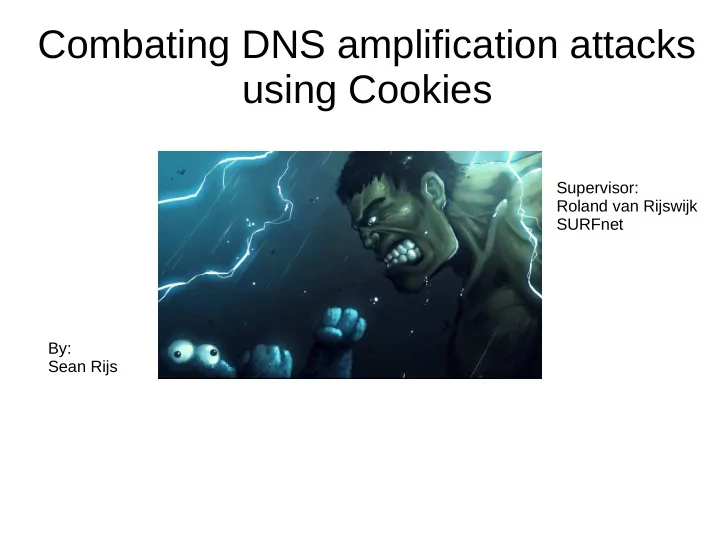

Combating DNS amplification attacks using Cookies Supervisor: Roland van Rijswijk SURFnet By: Sean Rijs
Agenda ● I am going to do my presentation
DNS amplification attacks 2 1 Stub resolver Recursive server Authoritative server Attacker (Open Resolver) 3 1)query ANY delaat.net 2)query ANY delaat.net response 1.1.1.1.... (and cache) 3)Response 1.1.1.1…. Target EDNS0 Table by Rijswijk-Deij et al. [ DNSSEC and its potential for DDoS attacks ]
DNS Cookies IETF Internet Draft ● By Donald Eastlake 2006-2014 – Authentication of source IP – Off-path ● No pre-configuration required ● Research question: – Is the draft effective against DNS amp. attacks?
Client/ Client/ Server Server Resolver Resolver Stub resolver Recursive server Authoritative server Terminology confusing?
Cookies OPT RR (EDNS0) hash(Resolver Secret | Server IP Address) hash(Server Secret | Query IP Address | Resolver Cookie) – May occur once – Proposed hash = FNV-64 – Max. 22 bytes
Server Resolver C (Resolver Cookie + CKPING) C (Resolver Cookie + Server Cookie + CKPINGR) C (Resolver Cookie + Server Cookie) Q(delaat.net. IN A ) C (Resolver Cookie + Server Cookie) R(delaat.net. 600 IN A 212.84.157.4) C (Resolver Cookie + Server Cookie) Q(delaat.net. IN AAAA) C (Resolver Cookie + Server Cookie) R(delaat.net. 600 IN AAAA 2001:9e0:....) ● Costs? – Initially 2x RTT – Hashing – Caching
What if? 2 1 Stub resolver Recursive server Authoritative server Attacker (Open Resolver) 3 3 just contains small error messages, no big amplification Target
Policy ● Disabled: do nothing with cookies ● Enabled: opportunistic (recommends RRL on server side) – Not a solution for recursive servers ● Enforced: Ignore everything without Cookies – Not gonna happen (in the near future) ● Policy is important, as it determines the incremental implementation
Source Identity Token (SIT) ● BIND 9.10-P1 (two months ago) 2x RTT has disappeared?
Differences SIT / Internet Draft ● Similar except: – Hashing: FNV-64, AES-MAC, SHA1, SHA256 – RRL: whitelists valid clients – Policy: no one is going to use it
Analysis of impact Stub resolver Recursive server Authoritative server ● Stub resolvers are stateless ● A lot of end devices: bound by release cycles ● Recursive server and authoritative are stateful ● Already use RRL
Measurements ● What do want to find out? – Do we need EDNS0 for normal use? – Do we need large response sizes for normal use? ● How? – PCAPs and EEMO
Measurement sources ● Stub resolver: www.nu.nl (with its adds) using: – Windows - Internet Explorer – OS X - Safari – Ubuntu Linux – Firefox ● Stub resolver: Alexa top 10 using: – Ubuntu Linux - Firefox ● Recursive server: SURFnet – 1500 – 2000 queries per second – 10m during a workday on noon Stub resolver Recursive server Authoritative server
Stub resolver ● No EDNS0 found ● No large response responses: – Size <= 512 bytes – truncated/TCP communication = 0
Recursive server ● 22% EDNS0 ● Average size – 133 B ● 99% <= 240 B
Conclusion/Discussion ● Based on our results, we suggest unauthenticated stub resolvers should be limited to a max. response size of 240 bytes ● Amplification reduced further: – 240 bytes = 6 amplification factor – 100M = 600 Mbit/s Table by Rijswijk-Deij et al. [ DNSSEC and its potential for DDoS attacks ]
Conclusion ● RRL should not be used – Especially on recursive server – But authoritative can also be effected ● Policy for incremental implementation must be changed ● Terminology: – stub/recursive/authoritative – The cookie is actually a Message Authentication Code (MAC) and not just a hash
Discussion ● Do we need to authenticate the server? ● Yes, it provides off-path defense against: – Last mile problem in DNSSEC – Cache poisoning (by Kaminsky)
Future research ● Need more measurements – to confirm suggested DNS maximum response size ● FNV-64 – The non-standard and untested hashing algorithm, which could provide performance gain. Is a performance gain required?
Questions
Recommend
More recommend